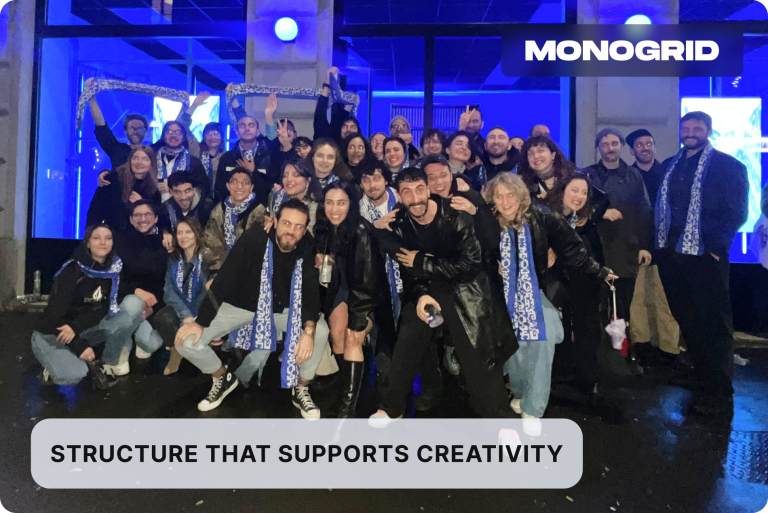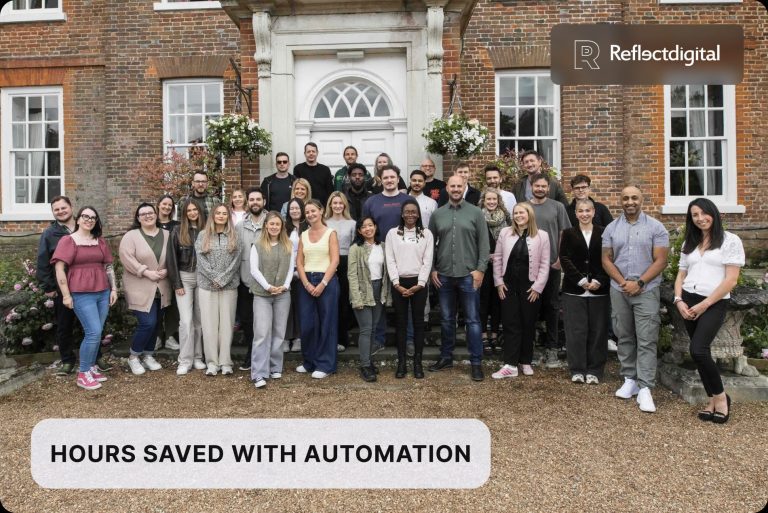Saffron Got Clarity on All Aspects of Business

Saffron is a brand consultancy of 90 people with offices in London, Madrid, Vienna, Istanbul, and Mumbai. Founded in 2001, Saffron specializes in creating, growing, adapting and transforming brands that range from the arts and entertainment industry to banking, energy and telcos.
How did Productive become and stay Saffron’s agency management tool of choice? We visited their Madrid office and spoke with Luz Erhardt, Chief Client Officer, Andrew Harb, Program Director, and Matt Atchison, Creative Director to hear all about it.
See also: Best Software for Consultants: The Ultimate Guide to Tools & Features
What did Saffron use as an agency management tool before, and how did you choose Productive?
Andrew: We assessed a number of systems and we came down to probably three that were short-listed and we felt that Productive, as a product, as a system, and based on what it delivered–really helped deliver against what Saffron’s needs were. We felt as though Productive was the best fit, and that’s why we went with it.
Luz: Before we were using a mix of different tools, quite basic—a mix of Excel and other online tools, but not very cohesively. We’ve been working with Productive for a couple of years now.
Matt: I think before, we could get away with things that were a little bit ad hoc, and you could sort of move things around, make decisions on the fly… but as the team has grown, we’ve definitely needed some tool to manage that.
Achieve Your Agency’s True Potential
Switch from multiple tools and spreadsheets to one scalable agency management system.
We Help Your Agency Reach New Heights
Switch from multiple tools and spreadsheets to one scalable agency management system.
Can you tell us about your roles at Saffron and in the context of using Productive?
Luz: I look at client services at Saffron and I also help with reporting. I work very closely with Finance, so we look at things like team utilization, billability, how much time we spent on new business for example. We also look at job performance, how effectively we are managing our resources. We look at future utilization, it allows us to plan a little bit better. Questions like: how tight are we gonna be in the team, do we have capacity? Productive helps us forecast—not only the performance of our jobs today, but of jobs in the future.
Andrew: I’m responsible for ensuring that the projects run to budget and time, working with the teams and essentially being the focal point on the projects, making sure that we deliver what the client’s brief is.
“The main benefit we get from Productive is planning, clarity, everyone working towards one system. It facilitates reporting, hugely. It’s very easy to use. Also, I think one of the biggest things for me is the fact that it’s constantly improving.”
How long did it take to implement Productive at Saffron? How quickly did you see benefits, and which ones?
Andrew: The thing that was seen straight away was that project performance and scheduling data was available for us literally at the click of a finger. I would say that whenever you implement a particular product or a platform, it takes a couple of months. But I think once everyone was using it in the right way, it was super obvious that when we needed project data, we were able to access it instantly.
The most important benefit from Productive, specifically for me, was the ability to be able to access my project performance and scheduling of the team in real-time. That, essentially, allows me and the team to be able to adjust the direction of the project, if need be, much sooner–rather than having to deal with it at a much later stage.
Luz: The main benefit we get from Productive is planning, clarity, everyone working towards one system. There’s a sense of shared ownership also, so it’s not that it only falls on one person. People can take ownership of their jobs and plan the whole thing out, you can collaborate with team members, so there’s also visibility about things. It facilitates reporting, hugely. It’s very easy to use. Also, I think one of the biggest things for me is the fact that it’s constantly improving.

You’ve been using Productive for over three years now. What value did you get out of it after more time went by?
Luz: I think reporting has definitely improved, it’s quicker, it’s faster, it’s more accurate. Forecasting has improved, 100%, because we have more intel about the business. So, for example, in a type of job A, how successful have we been? How many people have we used on that kind of project? Then it helps us plan for a similar situation in the future.
The big benefit we have is that everyone in the company knows what they’re on. Different people have different views, they have different access to different information, but everyone is aware of what they need to be aware of and hence, the planning, the work, the effectiveness is better.
“I felt really supported, I felt the platform itself is continuously evolving in a very positive way. It didn’t feel like just a plug and play and then, you know–we washed our hands of you.”
Can you tell us about your experience with our Support team?
Andrew: For me, what I was surprised with was the ease of use of the platform. What I was really surprised by was the fact that Productive continuously looked to improve the platform, to build out the platform, and they worked really closely with us. So, at the very outset of the project, we worked with the Productive team to set up what the needs of Saffron were. I felt really supported, I felt the platform itself is continuously evolving in a very positive way. It didn’t feel like just a plug and play and then, you know–we washed our hands of you.
Luz: Customer support works really well. There’s a person on the other side who responds immediately and gets onto it.
Any final thoughts you’d like to share?
Luz: Overall, I think Productive is really easy to use, it’s in constant improvement and I think it’s embraced easily by different team members… I would highly recommend it.
Matt: I think quite often, it’s easy to lose touch with the scope of a project and sort of see how long it’s going on and who you’re going to need along that journey. So it’s quite good being able to plan the long term, as well.
Andrew: I definitely think it’s a very close relationship between Saffron and the Productive team. When we need something, they’re very much there for us.
Achieve Your Agency’s True Potential
Switch from multiple tools and spreadsheets to one scalable agency management system.
More stories
Born Social Grew Over 25% In Under a Year Using Productive

Born Social is a global, full-service social media agency of 120 people who serve the needs of clients such as Guinness, Uber, and Nando’s. They operate and deliver content globally, with teams in the UK, France, Spain, Portugal, and Germany. We spoke with Born Social’s Managing Director, Kate Higham to hear about the benefits they’ve experienced since having switched to Productive.
Can you tell us about your role at Born Social?
I’m a Managing Director. I describe my role in two parts, part finance and operations, how we’re running the business as smoothly and effectively as we can, and part people and culture, so how we’re evolving our culture to meet the growth of the agency.
Achieve Your Agency’s True Potential
Switch from multiple tools and spreadsheets to one scalable agency management system.
We Help Your Agency Reach New Heights
Switch from multiple tools and spreadsheets to one scalable agency management system.
Let’s head straight into the learning curve you had with Productive. What has the UX been like?
I’ve only got positive things to say about Productive. It has really changed how we do things at Born Social. We timed the launch of Productive with the hiring of our first Resource Manager, so it was timed really well with us going through a change management process of centralizing our resource function. To have a fresh slate and a new tool to do that with was a really great opportunity.
When we were on the hunt for a new tool, one of the most important things for us was the user experience. You can’t underestimate finding a tool that feels like your company. Productive was exactly that for us. Onboarding and getting the team engaged in it has been super simple and smooth because of how intuitive the platform is. And, yeah, one of the things I love the most is that it looks and feels like Born Social.
How about customer success? What has your experience with Productive’s support been like?
I can’t speak more highly of the customer success and service team at Productive. We have moved from a tool where getting help and support was clunky—it was through a ticket system that could sometimes take days or weeks at times for requests. Having the internal chat function at Productive, along with the 3-month dedicated Slack Support for onboarding has been a real game changer.
In my role as a Managing Director, I can often be the funnel for requests, but thanks to the features at Productive I don’t need to be. Everyone can get their own help & support when they need it. That saves me time to spend on bigger things across the business. So, Productive’s customer success through those tools and that intuitive UX has been just an amazing time-save for us as a business.
“Even during month 1, the reporting we were getting out of there—we felt like the data integrity was right.”
When did you start seeing you were using the tool to the fullest?
We’ve been using Productive for around 8 months. If we look at the Scheduling, Budgeting, Time tracking, and Reporting—even during month 1, the reporting we were getting out of there—we felt like the data integrity was right. We were understanding how our time was being used better than we ever had before. We’ve had a big improvement in time tracking accuracy, particularly throughout the last quarter.
As an agency, what kind of reports do you focus most on?
Out of the key business metrics we’re tracking, I’m focused on 3-4 that are the most important to us. I immediately built a series of custom reports based on these key metrics, and it’s been so powerful to get such a clear picture of how we’re managing our time Recovery is perhaps our most important one. Recovery for us is like utilization but of just billable time.
Thanks to Productive’s Scheduling feature, and having our first dedicated Resource Manager, I would say we’ve been about a 10% growth in recovery so far. So you can really see the impact of better management of time in our commercials.
Next is our tracked vs. scoped time. So, of the time we sold, how much have we tracked? This is the metric that continues to grow in accuracy. With diving into that and really being able to see on an account-by-account level which roles are over-burning, or where we haven’t sold enough time—we’re getting all that clarity through the reports now.
We also look at account contribution. For us, that’s the profitability of accounts. That’s really helped us see which clients are bringing in a good margin and how we can make operational changes to improve that.
“Productive has played a key role in how we plan resourcing and hiring—really fueling that growth for us. Our headcount has grown 27% so far in 2022, and it feels like we’re on track to hit 30% growth by the end of the year.”
Since you started using the tool, you’ve grown from around 60 to over 100 people. Would you say that Productive was in any way beneficial for your growth?
Yes. It felt like for the first time we could see more clearly where we’ve got time available to sell, so that helped us use all of the time we had. Through the pipeline feature and Placeholder scheduling, we’ve got a clearer 90-day forecast.
All in all Productive has played a key role in how we plan resourcing and hiring—really fueling that growth for us. Our headcount has grown 27% so far in 2022, and it feels like we’re on track to hit 30% growth by the end of the year.
To wrap up, what would you say is the main benefit Productive brings you?
If I had to describe the one thing that Productive does for us it’s decision-making. Not just in my role, but across our finance and operations team. We are in and out of the platform on a daily basis, using the data and the reporting to help us make key commercial decisions about how we’re running the business, running our accounts, how we’re hiring and managing resources. It really is the tool for helping us make decisions.
Achieve Your Agency’s True Potential
Switch from multiple tools and spreadsheets to one scalable agency management system.
More stories
Productive Serves Makerstreet as a Single Source of Truth

Makerstreet is an Amsterdam-based collective of agencies with over 300 employees in four offices in the Netherlands and one in Spain. Makerstreet brings brands to life through design, digital products and services. We spoke with Fréderique van der Wijk, Operations Director at Makerstreet Marketing & Innovation and Makerstreet Partner Maike Vilé to learn how Productive facilitated their day-to-day work and growth.
See also: 11 Top Project Management Software for Designers in 2023
Can you tell us a bit about your roles within Makerstreet?
Fréderique: I’m responsible for the operations part in the marketing and innovation part within Makerstreet, and there are several units amongst that. I’m responsible for the planning and financial part.
Maike: I’m one of the managing partners at Makerstreet. I focus on internal operations in the fields of project management, HR, and finance. I’ve been here for about 10 years, so I’ve watched the agency grow from the small company that it was in around—well, I believe it was 12 years ago—really, a room in an attic, to what we are now.
We Help Your Agency Reach New Heights
Switch from multiple tools and spreadsheets to one scalable agency management system.
What impressed you or caught your interest when you first saw a demo of Productive?
Fréderique: Productive was more elaborate than the other tools we used, and for the whole Makerstreet collective, it was really important that we use one and the same tool for all our companies because now we are now working on more projects together. From the beginning, it was very user-friendly for us and I noticed team members liked using it, and management liked using it.
At first, people don’t like change, but then when you say “Just try!” Everyone was quiet and they said it was really easy, and now they find it really nice to work with.

How would you describe your operations and resource planning workflow now?
Maike: What’s nice about Productive is now we use scheduling as an actual data resource to create our financial forecasts. So the actual data in scheduling is the source for our financial forecasting now. So no more manual work, which is really nice and it gives everybody an extra push to make sure that their scheduling is accurate because it’s the basis of the financial forecast. So, if you want an accurate financial forecast, if you want that—you should have accurate scheduling. We’re really happy with that.
“With growth comes a bigger need for one source of truth, and that’s what it gives us, and that’s really important.”
What would you say are the top business benefits agencies can experience when using Productive?
Fréderique: I think the greatest benefit is that we have it all in one tool, in one—all together. Before Productive and before we used the other tool, we were like 15 people and an Excel might do the trick. Not to the best, but it did it. You know you have a lot in your head, so it worked… But, because we grow, that’s the main reason why we need it, and why it’s so helpful.
Maike: What’s really nice about it is it enables us to work easily together across the whole company, but it still gives us the opportunity to treat the different departments as separate businesses, which they still are.
With growth comes a bigger need for one source of truth, and that’s what it gives us, and that’s really important.
Achieve Your Agency’s True Potential
Switch from multiple tools and spreadsheets to one scalable agency management system.
More stories
DotControl Digital Agency Increased Their Forecasted Utilization With Productive

DotControl is a digital agency that creates cutting-edge products for globally recognized clients such as McDonald’s, National Geographic, DPG Media, and Dura Vermeer. We visited part of the DotControl team at their Rotterdam office to chat with Mark Landman, Managing Partner and Bastiaan Ludeking, Head of Operations. Keep reading to learn how their agency work has transformed with Productive.
Can you tell us a bit about your business? What types of clients do you serve?
Mark: We’re DotControl, a Dutch-based digital agency. We provide our clients with reaching their digital ambitions. We do this in three aspects: we focus on e-commerce, we do digital product development, and digital communication.
Achieve Your Agency’s True Potential
Switch from multiple tools and spreadsheets to one scalable agency management system.
We Help Your Agency Reach New Heights
Switch from multiple tools and spreadsheets to one scalable agency management system.
When did you start looking for a new tool and what problems did you aim to solve?
Mark: In our previous set-up we had a “tool soup”, a combination of a wide range of applications, providing us with different solutions for different problems. Then our quest started: to find one solution which could provide us support in the whole funnel: from sales to planning and budget management, but also on the BI part… and that’s when we came up to Productive.
What impressed you or caught your interest when you first saw a demo of Productive?
Mark: We really think that if you can bring a tool to your organization, it’s a tool that should support your organization. If you then bring a UI that is not very user-friendly and people need to work with it… At the end of the day, it becomes a hindrance instead of a solution.
That was the thing that also caught my eye—the fact that it’s very user-friendly, very intuitive, and it doesn’t take a lot of cognitive energy to find the thing you’re looking for. That was the thing that surprised us very positively and also made us go for Productive.
What would you say are the top business benefits agencies can experience when using Productive?
Mark: The first benefit is that it works integrated: so, from creating a deal, towards a budget, towards your planning, towards your actual time tracking, and then onwards towards your invoicing and insights.
The cool thing about Productive, I think, is the fact that it’s all very user-friendly, as I mentioned before. So all the screens are very easy to handle and they work really fast.
What I really love is the fact that you can play around with it and create your own views on every different aspect of the data. It’s very easy to filter, select and export data and also save your views. Especially if you combine it with the insights part, then the real power comes alive.

How would you describe your operations and resource planning workflow now?
Bastiaan: My role specifically within DotControl is that I’m Head of Operations, so I coordinate the team that’s responsible for all project management and client coordination… basically the management between our clients and our teams.
I think the main thing that we wanted to solve was, on the one hand, having one system in place for our entire project administration—so from planning to time tracking, to project reporting, to clients. The other thing was that we wanted to have a little bit more insights on projects, to know how our projects are running, and how are the financials looking. Productive really gives us more clear insights and possibilities to create reporting. That’s really a benefit for us.
I think especially for my role, I had a lot of support during the implementation because we transferred from our old systems to Productive, and the support there was really great. We had a dedicated person guiding us through using Productive, doing training with us, with all the people on the team. That really helped us to quickly adapt to Productive and quickly make a switch to this new system. I really liked that part.
“Due to the fact that we now have better insights, we also have better monthly reporting, which really supports the overall performance of the organization. We saw that the total performance of the organization was moving up, from 50% to 60%, from 60% to 70%.”
You say you’re data-driven. How did the data you got from Productive shape your agency’s future?
Mark: In the past, we were planning month-by-month, now we’re doing 90-day rolling forecasts on utilization to have way better utilization and at the end of the day, better billability and also more ease for the team. So you can discover where you’re overbooking and where stress exists. Do I have the right people on the right project? Which is not only a benefit on the financial side but also on the human side.
Due to the fact that we now have better insights, we also have better monthly reporting, which really supports the overall performance of the organization.
We saw that the total performance of the organization was moving up, from 50% to 60%, from 60% to 70%, which is really great and we’re really thankful for that.
Achieve Your Agency’s True Potential
Switch from multiple tools and spreadsheets to one scalable agency management system.
More stories
Productive Is Tandem X Visual’s One-Stop Shop for Managing Work

Tandem X Visuals is a social media production agency that drives brand and business growth through photography, video production, and social media marketing services. Always on the run, they needed an overview of their business and projects at all times. We spoke with part of their team to learn about the success they’ve experienced since they’ve been running their agency in Productive.
Can you tell us a bit about Tandem X Visuals?
We’re a video production agency based in Saskatchewan, Canada. Our focus is social media production through photography and video production. As a company, we believe that everyone has a story to be told and a way to represent that with visual excellence.
What were you using before Productive? Why did Productive make sense for your business?
Wyatt: As one of the owners of a video production company, Productive made a lot of sense for us just because of the scale of our business and the locations that we’re at, and the number of projects we have on the go. Productive allowed us to take everything that was up in the air and put it down into one spot, so we have an overview look and know exactly what’s happening at all times with the business.
Zach: One of the reasons why we chose Productive was because of how scalable it is and how customizable it is to our company’s specific needs.
Josh: Productive really gives us everything we need as a production company. There’s more than just resource planning, there’s more than just scheduling, there’s more than just budgets, there’s more than just task management. Productive allows us to run our entire company. It really is our one-stop shop for everything we would need to run our business.
Achieve Your Agency’s True Potential
Switch from multiple tools and spreadsheets to one scalable agency management system.
We Help Your Agency Reach New Heights
Switch from multiple tools and spreadsheets to one scalable agency management system.
“Productive really gives us everything we need as a production company. There’s more than just resource planning, there’s more than just scheduling, there’s more than just budgets, there’s more than just task management. Productive allows us to run our entire company. It really is our one-stop shop for everything we would need to run our business.“

How has Productive specifically helped you in your roles?
Marshall: As an editor, Productive makes my day a lot easier. Everything from the organization to our communication with the rest of the production team. It’s really important for me to keep focus and not constantly be stepping away from what I’m doing to check in on any questions that I may have.
Productive allows me to just very easily check in on a project, without completely detracting my attention from what I’m working on. Allowing me to stay in a good groove and keep my focus where it’s meant to be. I can very easily leave a comment for my producer or videographers on the same project. It’s just a really simple way of keeping conversations organized by project.
Josh: When I look at how Productive really helped grow our business, I look at the individualized impact that the software had. Every person in our company has a slightly different role—from videographers to video editors, to project managers, to video producers, to digital marketing managers. Everyone on the team has a different set of responsibilities.
Productive allowed us to navigate an autonomous workflow and the happiness I can see in employees when they’re able to just work and just deliver their best, and not worry about operational burdens and gigantic checklists or anything… I look at that and I go “that’s a success metric for us”.
How do you feel your business has transformed?
Marshall: Productive transformed our business in the best way possible. When we first started the company, we were a smaller team and the software we were using at the time got us by, but just barely, and we knew that we needed something a little bit bigger and better, just like Productive. It allowed us to scale the company and grow with us, and give us the tools and the abilities and the reporting that we needed to grow the company.
Josh: It’s not specifically the budgets, it’s not the task lists, it’s not the projects—it’s really the happiness that Productive brings our employees. It allows them to work in the way that they want to, as opposed to being forced to run an existing system that was built for someone else, with a different set of needs.
So, Productive really allows us to cater the software around our employees, to make sure that they achieve the best they can. And when they achieve the best they can, that means, as a company—we’re achieving the best we can.
Achieve Your Agency’s True Potential
Switch from multiple tools and spreadsheets to one scalable agency management system.
More stories
Infinum Scaled From 70 to 350 People In the Last Five Years Using Productive
Infinum Grew 350% Using Productive
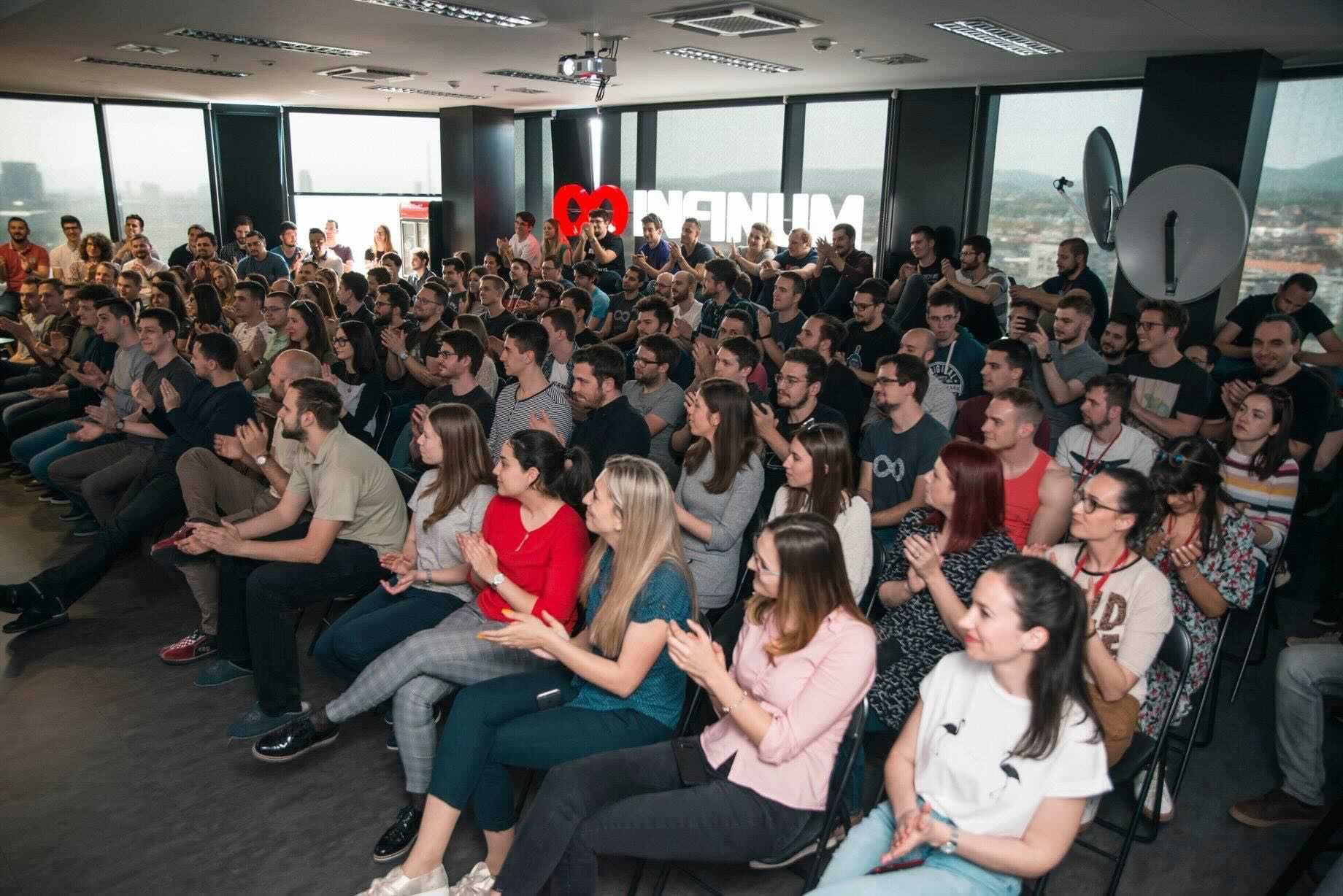
Recognized by trade and industry authorities such as Deloitte and Inc. 5000, Infinum is a renowned digital agency that partners with leading brands to envision and build beautiful digital products. For over 14 years, their apps and websites have been used by millions across the globe. In the past five years, Infinum grew from 70 to 350 people, while using only Productive as a tool for running their business. To learn how they successfully navigated their growth, we spoke with Luka Višić, Operations Manager and Ervin Jagatić, Head of Client Services.
Tell us about your roles and responsibilities at Infinum.
Luka: I’ve been managing the agency’s resources for the past four years. By manage, I mean I’ve been working on allocating our talent across different projects and clients and matching our talent with their needs. Around 250 people at Infinum are a part of production, so we have a lot of resources to manage on a daily basis. The job is very dynamic. Just last week, four or five projects were downsized at once. That influenced around 15 people to be left without work for the coming period. The job is really time-sensitive and it makes you have to learn how to communicate changes and expectations with so many different characters.
Ervin: I came to Infinum five years ago and started off as a Project manager. Before I worked as a programmer and product specialist. The great part about working here was having one place to track time and automatically see expenses and profit per each project. That was the first big benefit that I saw in Productive.
As our work developed and our team got bigger, I became Head of Client Services. Now I’m in charge of monitoring all our delivery and I make sure that our clients are happy with our performance and output. Through Reports, we started monitoring our production.
What did you use for resource management before Productive?
Luka: Before Productive, we used Hubplanner. Around three years ago we switched to Productive when they released the Scheduling feature. What’s great about using Productive’s Scheduling feature is that we gave a lot of feedback while it was being developed. It’s almost like we got a tailor-made resource planning tool. As the agency is constantly growing, we’re now facing a new challenge: how to keep everything visually accessible. Currently, we can get a high-level view of schedules by putting a few screens together.
Learn How Infinum Grew 350% Using Productive
Download the full case study here.
We Help Your Agency Reach New Heights
Switch from multiple tools and spreadsheets to one scalable agency management system.
What did project management look like five years ago?
Ervin: Back then, task management was quite rudimentary, but Productive has developed a ton ever since. After becoming a team lead, I started working with the rest of the project management team on a higher level. We were looking into Reports in Productive. Nowadays, not a week goes by that I don’t go through reports.
See also: Website Project Management: Expert Guide to Web Builds
“Reports have become our central place to follow key metrics, analytics, numbers, graphs, and—simply said—the pulse of our agency. Currently, it’s hard to imagine what our jobs would look like without reports. It’s a lock-in feature for us, for sure.”
You’ve been using Reports since 2016. How much easier have your jobs been since then?
Ervin: The great thing about decision making at Infinum is that thanks to Reports, each decision is based on data. Our business decisions are never made on an inner feeling or intuition. Productive gives you answers to questions like what’s the profit, how much are the expenses, what’s the projected revenue, what’s the utilization? That entire set of key metrics is what gives management a basis to move forward. Without tracking time in detail and keeping track of expenses, there’s no way you can make the best possible decisions.
Reports have become our central place to follow key metrics, analytics, numbers, graphs, and—simply said—the pulse of our agency. Currently, it’s hard to imagine what our jobs would look like without reports. It’s a lock-in feature for us, for sure.

You’ve grown 350% in the past 5 years. How has having all these key metrics at your fingertips helped you with hiring?
Luka: Hiring is another area of our work that’s extremely tricky, so having all our data in one place helped us immensely. There’s no following a gut feeling, wondering if we have or won’t have enough work. We go and check to see: do we have a lot of overtime? How many hours were tracked on each project? Then we check out our teams and see which team is tracking more overtime and which teams are tracking more production hours. All that data helps us understand whether we need to hire more, charge more, give a client a discount, increase a budget, etc.
Growth in numbers:
Stable increase in billable utilization year on year
Profitability of projects through time: in Q1 and Q2 of 2021, we saw a 27% increase in profit
Better decision-making based on data, not assumptions
On a weekly basis, our project managers save 3 hours of time
Our forecasting horizon increased to 180 days (two business quarters)
Our number of clients doubled in the last four years
Which key agency metrics and numbers do you regularly keep an eye on?
Luka: On a daily basis, we monitor:
Production utilization by teams
Forecast of production utilization
Overtime by teams and people
The Overtime by teams and people insight gives us a clear picture for hiring and the Who’s late with time tracking report is super important for us so we have the most up-to-date reporting possible.

Production utilization by teams
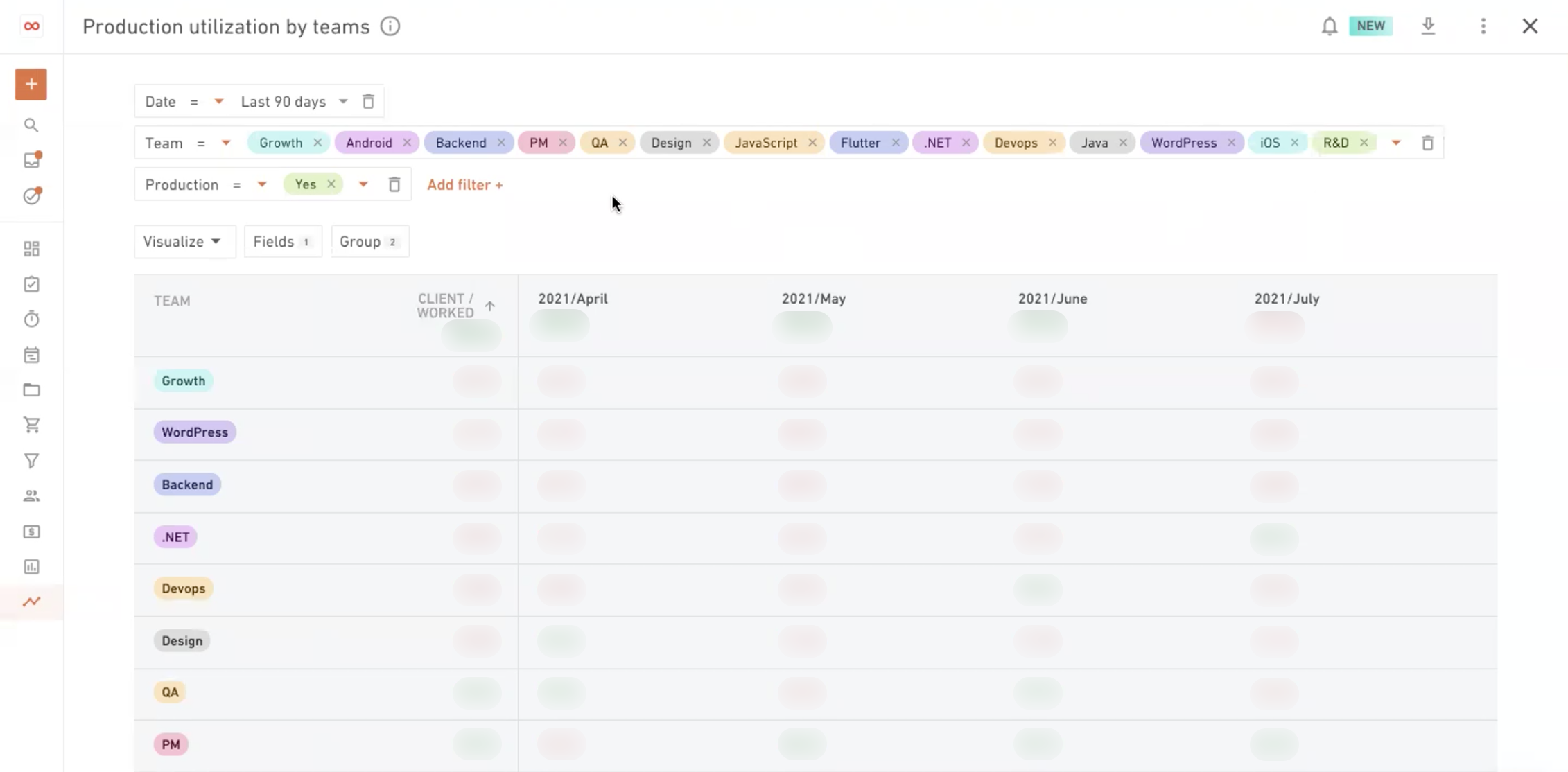
Forecast of production utilization

In terms of forecasting, one of the most important metrics we have to watch is: do we have people available in the next 2-3 months, or not?
Ervin: Other insights that we follow on a daily and weekly basis are:
Recognized revenue per quarter/year
In this report we compare the revenue we forecasted the year before and recognized revenue from last quarter.
Production delivered hours by engagement type: in-house vs. contractors
This is another piece of data we monitor: the amount of hours contractors work in comparison to our in-house teams.
Project level insights
The great thing about this report is that we can easily sync with the rest of the production team and quickly give clients insight as to where we stand with a particular project.
How much time do you think you’ve saved using Pulse?
Ervin: I think it’s more of a trigger for getting certain people informed. Some time does get saved, but what’s better about Pulse for me is that you don’t have to actively think about keeping an eye on certain metrics. For example, if I want our financial manager to get informed about all the budgets that were closed in the past quarter, I just set up a pulse to automatically do that for me, instead of me spending time on it and thinking about it.
How would you feel if you didn’t have Productive?
Ervin: If someone told us that we’d need to move to a different tool, I think that’d be nearly impossible. I think it’d take a year and a half to migrate to one or more tools.
Luka: There was no point in time when we saw that we needed to use an additional tool. We’ve been monitoring all our key metrics in Productive since the beginning, and I can’t imagine work without it.

Tell us about the integration with Slack.
Ervin: Since Slack is our primary communication tool, now we save some time on regularly checking notifications and updates in Productive. Since we’ve connected Slack and Productive, now we get automatic updates.
How has Productive’s Invoice Builder been beneficial for you?
Ervin: Auto-generating invoices in Productive is a game-changer for project managers in Productive. There’s no copying and pasting and double-checking if all the data is accurate. Productive has really eliminated the chance of human errors. All you need to do is make sure that everything in your budget is correct and then you pull that information up when you go to build an invoice. After that, it’s one click to invoice and the Finance team takes over. On average, I save a few hours per month on invoicing.
Last, but not least: have you started managing PTO in Productive, too?
Luka: We’ve recently switched from Calamari to Productive to manage time off. The flow around approving and managing schedules is complicated in our agency. With over 350 employees, there are many people who need to be informed about time off, and having that in Productive now is going to be a big money saver in terms of overhead costs.
Achieve Your Agency’s True Potential
Switch from multiple tools and spreadsheets to one scalable agency management system.
More stories
SRH Uses Productive As Their Single Source of Truth

SRH has been using Productive for two and a half years. As an agency, they focus on adapting their processes based on their clients’ needs, and using Productive has helped them stay flexible in responding to those needs. We spoke with SRH’s Managing Director, Jonathan Gundlach to hear how SRH became more efficient and grew using Productive.
Tell us a bit about your agency and your role at SRH.
We’re SRH and we’re about 7 years old. Since I arrived three years ago, my role has shifted and grown. First I was a project manager, then I was the operations manager when we started using the tool, and now I’m the managing director!
We recently reorganized internally to give our teams more autonomy and responsibility in SRH’s growth. I’m excited about the way that we’re able to manage everything in Productive, especially the project financials, overhead costs, and the expenses and budgets within projects. The more I learn about the tool, the more I love it. We’re excited about all the offerings it has for us.
What’s your background in the agency business and what’s your experience with business management tools?
I’ve been in the industry for about 25 years now. Throughout the years I was in charge of finding agency management tools. I came to SRH three years ago when there were about 10 of us on the team. There was no time tracking and we did our invoicing through spreadsheets and Quickbooks.
Achieve Your Agency’s True Potential
Switch from multiple tools and spreadsheets to one scalable agency management system.
We Help Your Agency Reach New Heights
Switch from multiple tools and spreadsheets to one scalable agency management system.
So your role within the organization changed: you used to be a project and operations manager, and now you’re the managing director. What benefits are you experiencing for your role now?
Before, as the operations manager, once something became a project I was spending a lot of time managing information within those projects. Now I’m mentoring Sara and Julie—our project managers—on how to manage budgets and do things within the tool. They are both uber-talented, smart people and are now showing me better ways to do things, which is awesome.
I think it’s really helpful that we’re all using Productive on a daily basis. Now my use of the tool is on a higher level though, and more focused on looking into reports and data.
“Productive gives us a central place to see where we are. It actually shows us how we’re doing on our budgets and it gives us a place to manage our out-of-pocket expenses.”
Can you remember what it was like managing projects and operations before Productive? What did you lack?
Before, above all, we lacked transparency. At that time our projects were simpler and there weren’t as many of them, but just the fact that we were using various spreadsheets made it hard to have all the data we needed.
Productive gives us a central place to see where we are. It actually shows us how we’re doing on our budgets and it gives us a place to manage our out-of-pocket expenses. We also do some pretty complicated video shoots and production and it helps manage those complex projects.

Does it help you monitor your profitability?
I think that in project management there’s a tendency to focus solely on profitability, but it’s inevitable that projects will go over budget, and that’s ok. However, it’s important to have transparency on where that stands, and Productive gives us that visibility.
The other feature we really embraced is having multiple budgets within a project. Now I can close sections of a project and I have the ability to move money around, which I really like. We just started using the PTO, the time off management feature, and that also makes my life easier. I also really like how Scheduling gives me an overview of resource planning.
“I tried a lot of different software in the past and none had the sales to project management, invoicing to task and resource management in one tool. To me, all those features are the holy grail of an agency management tool.“
Would you say that Productive is an end-to-end agency management tool?
Absolutely. I tried a lot of different software in the past and none had the sales to project management, invoicing to task and resource management in one tool. To me, all those features are the holy grail of an agency management tool. I knew from my experience that it would help us grow. Now I can’t imagine using any tool other than Productive.
I’m sure you have future plans for SRH. Are you confident that Productive will be able to support your growth plans?
Yes, absolutely. The modular aspect of it suits our growth. We have all our people in Productive divided into teams which we assign to clients. If only half of the clients are currently active, using the flexibility of custom fields we can see who’s active and inactive. Once you understand how things work in Productive, it’s very flexible and there’s a lot of possibilities for growth and expansion.
What was the learning curve like and how was it onboarding the team?
Around 80% of the agency uses Productive for time tracking. The project managers and I are using it most and we’re still learning as we go. We embrace the changes that keep coming and we regularly make recommendations that we think would make things easier and better. I think they’ve been received well.
Would you say that your agency’s work has become more streamlined?
Yes, I’m very disciplined around putting new opportunities in as sales deals and tracking them all the way through, then marking them as sold. That’s an area where I know I’m putting in the data the right way. With time, I’m sure we’ll be getting great results out of the data in reports.
Last, but not least: how would you feel if you didn’t have Productive?
Just based on my history and experience, if we weren’t using Productive now, and we’ve been using it for two and a half years—there’s a very good chance that whatever we would have wouldn’t be fitting all our needs right now. I’ve looked at other tools and I’ve seen how they work. We’d probably be integrating with other tools and that would be frustrating and time consuming.
Achieve Your Agency’s True Potential
Switch from multiple tools and spreadsheets to one scalable agency management system.
More stories
How Contra Agency Makes the Most of Productive’s API

Contra is a leading London-based agency with over 20 years of experience in all things digital. Since April 2020, Contra Agency has been managing all its design and development of digital content, websites, and web apps in Productive.
After less than half a year that Contra’s been using our platform, we spoke with co-founders Roberto Ciarleglio and Ben Edge to see how they switched to working remotely and made the most of Productive’s API.
Tell us a bit about Contra. What markets do you operate in, who are your clients?
Our work is split into two main categories: we help our clients with their marketing and we help digitally transform them with websites and web apps. We work mainly in B2B. Some of our clients are big finance companies, quite a lot are in the tech space, and we also work with some top universities—like Oxford and Cambridge in the UK.
You switched to Productive recently, right?
We started the process about nine months ago. We found Productive, signed up for a free trial, had a few demo calls. To give you some background, when we started our agency 20 years ago, we didn’t have any agency management tool at all. I don’t think that even existed back then! Soon, we realized that we need to be organized.
The first thing we started out with was Sharepoint. That served us for a few years, but we lost money realizing that we didn’t invoice certain projects. Then, about 15 years ago, we started the hunt for a system.
The first one was Traffic, which was a disaster. The basics were wrong, and it would calculate incorrectly. Then we switched to Streamtime. Those two tools just didn’t do enough. Alongside those, we’d use BaseCamp, Trello, and various other tools. Streamtime did invoicing, but wasn’t suitable for project planning and clients to use.
Part of our journey was to find a system that could do everything that we needed it to do. We’ve looked at so many of these systems and done so many trials that we knew what a lot of our questions were.
Achieve Your Agency’s True Potential
Switch from multiple tools and spreadsheets to one scalable agency management system.
We Help Your Agency Reach New Heights
Switch from multiple tools and spreadsheets to one scalable agency management system.
So the number one thing you were looking for was to have an all-in-one tool?
I guess either a tool that could do everything or a tool that we could integrate well so that collectively, it could do everything without us losing things. Your system is good because it does a lot, but also the API is great so we were able to integrate it with our other tools. For example, it doesn’t have a messaging system that can compete with Slack, but we can integrate it with Slack.
I think the other thing that we really like is that all our staff is really happy with the switch. The user interface is fast and smooth, it’s a very single-page application—and it works really well. You’ve hit this balance where it’s powerful, but it’s not too complicated. Our previous system was Accelo, and it was massive. You could do everything under the sun, but you had to do it in a certain way.
Related: 15 Top Accelo Alternatives & Competitors for Agencies
What’s good about Productive is that it’s powerful, but it doesn’t force you to do things in a certain way. You can be creative in the way you use it. You don’t want to fight a system, you want to work with a system.
See also: Scoro vs Accelo vs Productive: Which is Best for You?

It’s important that your team adopted to it well!
Now our team can fill out timesheets really quickly. Even if it’s only a small amount that’s causing a delay. Eventually, when you have to do loads of time entries, it becomes very laborious. Whereas in Productive, you can do your timesheet very, very quickly.
And how was the transition to remote work for your team?
A lot has changed in the company since we all started working from home. We had to instantly form new habits. Combined, the team has probably been working more efficiently than it has been for a long time.
Can you let us in on how your team is using the tool? What do your daily stand-ups look like?
We have the Scheduling view up on our screen when we do our daily stand-ups and two project managers who run the meetings. We tend to not plan too far in advance, only a week or two, though we may have some rough placeholders down the line.
Placeholders are very quick and I like the way they feed into the timesheets. When we first started to look at using placeholders, we came from a background where every task in the plan was scheduled. It took us a while to realize the benefits of blocking time to work on a project.
“The reason we look at Scheduling is not so much to look too far in advance on a daily basis, it’s to look at today’s workload while having a sense of why we need to do something—because there’s something else coming up in the near future.“
So Scheduling is your main starting point each day?
We base our stand-ups around Scheduling because it gives us a sense of what the whole company is doing and you can see into the future a bit. The reason we look at Scheduling is not so much to look too far in advance on a daily basis, it’s to look at today’s workload while having a sense of why we need to do something—because there’s something else coming up in the near future.
Is there anything you particularly like about the tool?
It’s really encouraging to see that there’s a roadmap and features coming out regularly. It’s also really nice to have a dialogue with you guys, especially in the chat.
Thanks, we’re constantly working on the tool. Every week we go through around 50 customer requests to see what many people need.
We wouldn’t have wanted to take on a product that wasn’t constantly being improved. It’s really encouraging because we know that software is never finished.
“Because Productive is flexible, we were able to create some patterns for more flexible projects and other patterns for more rigid projects. This has actually helped us to be more consistent. If we need to create another project structure, we can still do that because we have the flexibility with the boards.“
Even though you’ve only been using Productive for a few months, do you think that you’ve mastered the platform? What was the learning curve like for you?
It was fairly intuitive. My biggest questions were around how we do things as an agency. I was really keen on speaking with your colleagues to ask how they’d approach certain problems. I’m prepared to change the way I think if it makes sense. I don’t really want to fight a piece of software and make it do something a certain way if it wasn’t designed for that.
In terms of the learning curve for our team, we had one screen share and nobody’s really struggled since. It’s an open book, a blank canvas in some areas. You’ve got relationships and entities, customers, projects, contacts, companies…all these things are fixed. But how you run a project is very open. You can have one board, you can have ten boards. You can have one budget, you can have 100 budgets in one project. There are so many different ways of approaching it.
To be clear, we run different projects in different ways. Some are agile, some waterfall, some linear. Because Productive is flexible, we were able to create some patterns for more flexible projects and other patterns for more rigid projects. This has actually helped us to be more consistent. If we need to create another project structure, we can still do that because we have the flexibility with the boards.
We wanted to work out how to structure certain projects and teams so that we could give our project managers a framework that would work.
Were you pleasantly surprised by a certain feature or a capability of Productive? New metrics, data, anything you didn’t expect when you bought the platform?
From a business level, now we make better decisions regarding our utilization. I’m understanding new things about profitability. I’ve made certain assumptions before, and some of those assumptions have proven to be wrong. For some projects, we weren’t sure how far over budget we were, and now we can really see.
In terms of features, I’m particularly impressed with your reports. The filtering and the options you can do with those reports is too much! The fact that you can add custom formulas, change how things are rounded, enable colors to change above a certain number… It’s pretty impressive!
“It’s difficult to create something that looks very simple, but actually has a lot of depth to it, in a way that you can customize, but it isn’t difficult to customize. That’s the sweet spot of software. I think you guys have done a really good job there.“
So the fact that you can customize data and how it’s reported is something that you’re really happy with?
It is because we know how difficult it is to do that.
I think of this a lot about Productive: when you look at it, at a glance, it seems very simple and maybe even like it doesn’t have a lot of features. But then when you start using it, you realize that there’s a lot of very good attention to detail, and that’s a really difficult balance in software.
We create software for our clients as well, and it’s difficult to create something that looks very simple, but actually has a lot of depth to it, in a way that you can customize, but it isn’t difficult to customize. That’s the sweet spot of software. I think you guys have done a really good job there.
Our customers from Texas to South Africa are saying: when switching to remote work, everything was already there, we just made sure they would really track time on a daily basis so we could plan resources better. It’s great to hear that you’re experiencing business benefits using Productive, too.
I think you need to run it like a machine, but it needs to be fun as well—otherwise, it’s like being in the army. Productive has got a good balance of being structured, flexible, and enjoyable to use.
In terms of integrations, there are a lot of things we’ve done ourselves. When we build a typical web project, we go through a number of phases. We try to do as much QA and validations upfront as we can. What we’ve been able to do with the API and the integrations we’ve written with Slack is create a whole series of board templates: all the different projects, tasks, and TODO lists. Anything that we expect to be ticked off before the next phase. A project manager can just go to Slack and create a new project for QA, and the command goes off and creates that board. We’ve become more efficient.
Let’s talk about that API client that you came up with. Was the Slackbot you mentioned the main idea behind it, or did you create any other integrations?
We did quite a few. The Quickbooks integration was the first one. The integration you’ve already got with Quickbooks is great for getting invoicing done, but there were a few gaps that we felt were a challenge for us. For example, it’s common for our staff to create an invoice and then for someone to say “Can you add in a PO number?” or “Can you change the date on it?” With the way the integration stands at the moment, you can’t re-push the invoice into Quickbooks.
Another thing is that we have 20 years’ worth of data in QuickBooks, where different service lines are linked to different incomes. To not lose that data going forward, we wrote a webhook that listens to a new update or a new invoice, reads through your service lines, checks with QuickBooks, then updates the new invoice and sorts it all out.
That was where it started. We only needed four or five endpoints on your API, so we just built them. Then, we thought it’d be really great if we had templates for reports, so we built that. After that, we thought it’d be good that support emails we receive would automatically turn into tasks. I’ve written probably a quarter of the endpoints. I just kind of saw it as a challenge and decided to write out the endpoints that we were using. So I went a bit crazy and wrote the whole thing!
A lot of our integrations are within Slack. We use a lot of Slackbots to trigger things in Productive, and we use your webhooks to trigger things as well.
It’s really nice that some companies are willing to shape Productive in a way that fits them.
Well, that’s really our brand: we call ourselves “doers who get it done”. We’ve always been people who build our own things. The thing about your API is that it gives us the power to do what we need to do and fill any gap that we need to—because it’s flexible enough.
Achieve Your Agency’s True Potential
Switch from multiple tools and spreadsheets to one scalable agency management system.
More stories
Using Productive, DotDev Has Grown 50% YoY For the Past Three Years
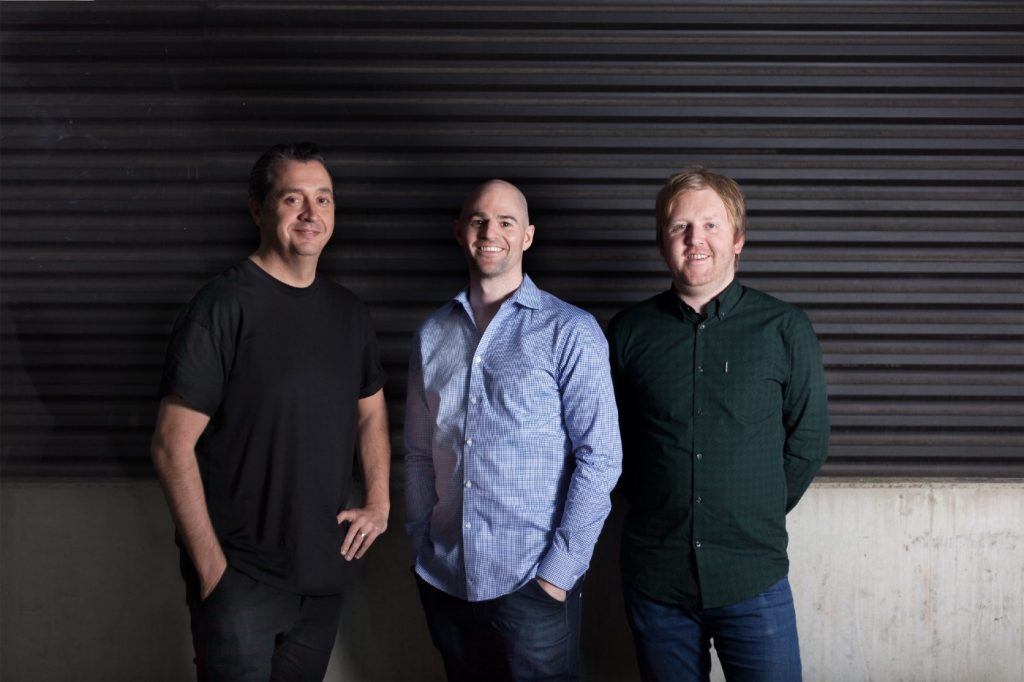
DotDev is a product development company with three core values: creating long-lasting relationships, reliability, and excellence in everything they do. Following these values has gained them a reputation as Australia’s leading omni-channel integration partner across platforms such as Apparel21, Retail Express, and SAP. After 24 months that DotDev has been using Productive, we chatted with Co-founder and Technical Director, Brendon Nicholas to see how their business has transformed.
You specialize in e-commerce, right? Do you have more diverse clients now after the crisis started? What does your company look like now, in 2020?
We’re a team of around 34 now. Probably 60-70% of our work is related to fashion brands, the rest is product development and larger retailers. Now there are a lot of startup-based things, like home delivery. A lot of brands are going from large, retailer models to online models. There have been a few bigger changes since we started using Productive. The biggest change from the project management side was when we got to a team of 20. We broke down into three separate teams and brought a Tech and a Delivery Lead in.
Which industries do you serve?
Our customer base has changed from the quantity of projects, we’re definitely not doing as many at a time. We moved to a lot larger budgets and a lot longer projects, and they’re a bit more technical and custom, rather than smaller, higher-volume stuff we were doing before. I’d say we manage around 7-8 larger projects at one time. Support work has definitely increased—that’s probably 40-50% of our revenue now. So when we launch projects, they go into support and optimization.
Achieve Your Agency’s True Potential
Switch from multiple tools and spreadsheets to one scalable agency management system.
We Help Your Agency Reach New Heights
Switch from multiple tools and spreadsheets to one scalable agency management system.
You said that the sizes of your projects have increased. Does that bring more risk?
It definitely brings more risk. The more technical and larger you get, the more expectations there are. We’ve gone through 12 months of rapid growth and doing more technical things. The fact is, if you have big aspirations, planning is fundamental to ensure that growth happens. High aspirations also need reliable systems and efficient processes. This is crucial to ensuring that the level of quality remains constant as the business grows.
“If you have big aspirations, then planning is fundamental to ensure that growth happens. High aspirations also need reliable systems and efficient processes. This is crucial to ensuring that the level of quality remains constant as the business grows.”
What were your operations like before? Can you name the tools you tried before Productive? What were some pain points you were going through?
To be honest, we have tried many, many different tools. I think 20 or 30 at the time. Over the last 12 months, I don’t think I’ve looked at what’s going on with other systems. I’ve been pretty happy with the way Productive is working. We went right through from things like StreamTime and bespoke platforms like that, which kind of offer a similar approach, right through to enterprise platforms. We’re content with the pace you guys are moving.
We really struggled to find a system that not only provided all the features we required but was also fast and user-friendly enough that our team could do what’s required without having to read a 30-page manual. Even simple things like releasing checklists on tasks actually have a massive impact and provide us a lot of functionality to be able to manage end-to-end. It’s features like that that have allowed us to bring in our delivery plans from external tools into one platform.
“We really struggled to find a system that not only provided all the features we required but was also fast and user-friendly enough that our team could do what’s required without having to read a 30-page manual.”
So, would you say that Productive’s roadmap and development are actually following your needs as well?
Yeah, definitely. Having that relationship with you guys, being able to get responses quickly, and knowing that it gets heard is a big benefit for us. You’re not just another customer where you request things and it gets lost in the backlog. There have been many different things we’ve recommended over the years, and we’ve seen those get released in weeks, sometimes months after. For us, that makes us feel good as a customer.

You’ve clearly tried out a lot of different tools. So what was the learning curve like for you in Productive?
I think that’s probably one of the single biggest things why I eventually came across to it. Productive acts and behaves like an enterprise tool, but it doesn’t feel like it. When we looked at some other tools, we really needed to understand the terminology and go through their manuals and training documents to really get an idea of how to go through the end-to-end flow. The way we explain it is: It’s like Trello, it’s super simple, but it has a whole lot more. It’s got multiple boards and it does end-to-end, not just the boards part.
How about your delivery team? Because they’re mostly involved with Productive, was it hard for them to learn how to use Productive—and use it in the best possible way?
I think it was pretty seamless, to be honest. Always, the first time onboarding, when we get a new delivery team, it’s a couple of hours of onboarding. We take them through so they can get familiar with the task. I think it’s got a UX they’re familiar with.
Do you have difficulty with getting people to track time? It’s important for your utilization to keep things up to date in real-time. Has that ever been a challenge for you?
We have a Delivery Lead that manages the resourcing, time approvals, and task updates—that’s definitely improved things a lot. The team understands the importance of tracking. We have a generic, company-wide delivery board, where every moment they understand what they’re doing today, what they’re going to achieve. We update it at the end of the day, going through what we completed and any issues or blockers for the next day. The only real process change we recently had to make was getting everyone to write their daily tasks, to map out what they’re doing and what they’ve done at the end of each day.

How about we touch back on the lockdown situation. In the beginning, everyone was wondering “Are we going to be able to survive this?” Have profitability reports in Productive additionally eased up the anxiety for you?
For me, it was an easy move, because I knew I had the visibility. I know I can jump in anytime and get an understanding of budgets, time, what people are doing, or what’s going on within the business. I’ve spoken to another couple of directors of agencies in Australia and some of them have really struggled to make the shift. They’re using really large, enterprise, ancient tools that just don’t have the real-time capability. The financial reporting that we can get in a couple of clicks—they’re having to get their accountants to go in and drill that data in Excel. Having that insight made it pretty easy. I’m out here in the countryside, pretty relaxed in the middle of this.
After using Productive for about a year and a half now, how has your role shifted, has it become easier? Are you focusing on more decision-making, strategic thinking? How has it changed?
My role was very heavy across the process and workflow of the business 12-18 months ago. Putting in tools like this has allowed me to implement those processes, get the team across it, then sit back and not really have to worry about things. I’m working with the team a little bit closer, upscaling, and playing a lead role across some of our solutions.
Were there things that you discovered in Productive that you didn’t expect you would benefit from at the beginning?
The benefit was finding one system that’s not overly complicated, that can do end-to-end. That was probably the single biggest thing—reducing the amount of tools, platforms, and systems, and using just one. The other benefits that came up, which were never really an area of focus, were the Reporting, the financial capabilities and understanding. Having a platform that considers everybody’s salaries, the operating expenses of the whole business, and feeding that into project budgets and looking at the internal time vs. client time, gives us a lot more real-time and accurate view of the profitability of actual, specific projects. So that was never a focus before, but it’s something I use more than anything right now.
You said profitability wasn’t really looked at before, it wasn’t the number one reason why you purchased Productive. Maybe it wasn’t as important at the time?
I guess I probably never thought I could find a tool that was end-to-end: from leads, through management, financials, insights and reporting. Having it all in one has allowed us to drop a couple of the other platforms we used.

Was this already an internal process in DotDev before—to analyze your profit margins, compare it against your rates, calculate average rates per client?
I probably take it for granted now, but no, not really (in the same sense). There was a lot of guessing before. We knew that there were hours spent and hours that were quoted, but that was about it. Definitely not down to a level of individual resources or how much time we spent on internal projects. That’s a key thing that we get out of the reports that really feeds into our utilization and resourcing. If we know we’re spending 30% of our time on internal projects, then we know we’ve got the capacity to take on more work.
“That’s a key thing that we get out of the reports that really feeds into our utilization and resourcing. If we know we’re doing 30% on the internal projects, then we know we’ve got the capacity to take on more work.”
Did you calculate utilization before? Did you use other tools?
Not really, to be honest. We definitely didn’t have the visibility to look at.
So, how did you plan hiring before?
A key thing for us around the Scheduling is to essentially place a hold on the projects that are coming in. Now, everyone is locked out for about 3-4 months. We also place a hold on all the deals and sales we have in the pipeline. Now, we can get visibility for over 3-6 months, other than just 4-8 weeks and having to guess. Before, hiring always seemed a lot more like a risk and unknown because you’re kind of guessing based on a gut feeling, which isn’t always the best when you’ve got a lot going on.
Has that eased up the chaos? Do you see more overall satisfaction from your employees?
Yeah, I think less chaotic is the feedback I get, especially when we’re trying to do a team of 20 all at once. They can see two months out what they’re going to be working on, to think or prepare. Maybe they’ve got a bit of upscaling to do, or some research they want to do based on the projects coming in. For them, that just brings on a little bit of anxiety. So, as much visibility and stability they can have, makes it all easier.
Do you have any growth numbers you can share that you think are maybe a product of the switch over to Productive, having everything more organized, all in one place?
A standard QA/UAT phase was taking us around 120-180 hours. We’ve been able to launch a really big enterprise site on the same level, and that went through a testing phase of 60-70 hours. Obviously, there’s a lot of different factors that go into that, like technology and processes, but having all that centralized has made managing those phases remarkably quicker. I think it’s the context of jumping between different tools, then jumping back to Productive where you’re managing the support—that would waste a lot of time.
Any other measurable impact that you can share?
I think you can directly relate that we’ve grown 50% YoY for the last three years. I don’t think we would have got past 12 employees if we didn’t have Productive. The ability to scale and not have to change processes because it supports any scale or size that we need.
Do you use Productive end-to-end, from pre-sales to invoicing and billing? Do you have a standardized process that you use as a template?
Being a technical company, we kind of went back and forth, toying with the idea of bringing our delivery plans out of Productive. Around 3-4 months ago, we brought everything back from Gitlab into Productive. We’re trying to manage everything end-to-end there. From the initial scoping and delivery boards, we’ve broken down tasks and estimates and everything that the developers are doing, to the QA and testing phases, where the clients are logging issues. Having everything in one place was enough benefit for us to move back to Productive. It’s simpler for clients to understand, they only have access to one thing. From the team’s point of view, they know that they need to come in and look at what they’re doing. Everything that they’re involved in is in Productive, rather than being fragmented out into different systems.
Is there any project you’re especially proud of that you’d like share?
For us, the biggest shift over the last 12 months has been moving to headless e-commerce. It’s a big shift in the way we approach things, how flexible we are, and what we can provide our clients. We launched one for the AFL store, which is quite a large retail chain here.
Do you have a favorite feature that you think is the coolest part of Productive?
Over the last six months, I’d say project checklists! I know it seems so simple, but it’s allowed us to bring delivery boards and testing all into one tool. The ability to add filters, pivot the data, charts, have raw data…that saves a lot of time. Essentially, we don’t have to have numerous Google Sheets and exports. We have different data across the platform.
Achieve Your Agency’s True Potential
Switch from multiple tools and spreadsheets to one scalable agency management system.

